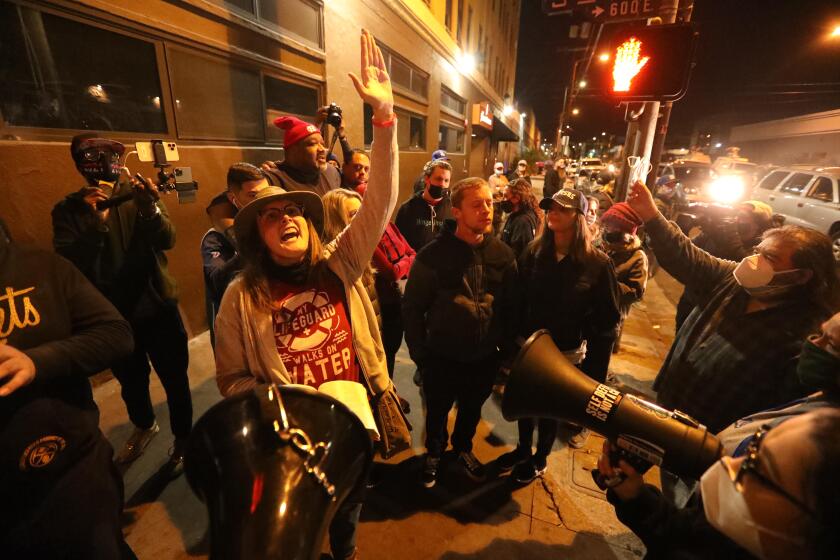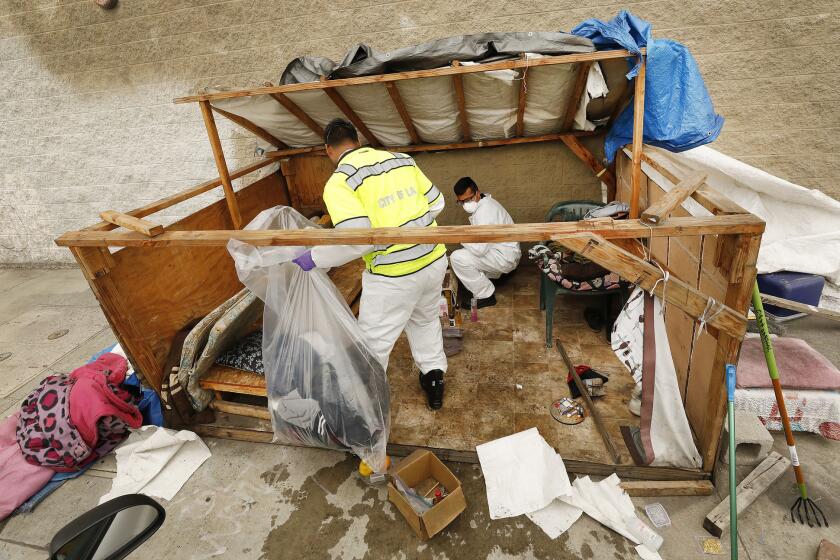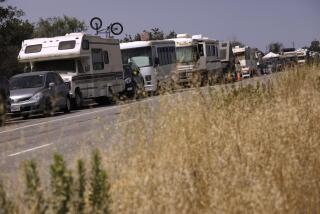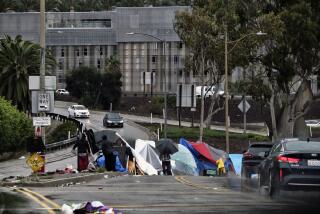L.A. homeless sites ‘overwhelmed’ by COVID-19: ‘These are the toughest times’
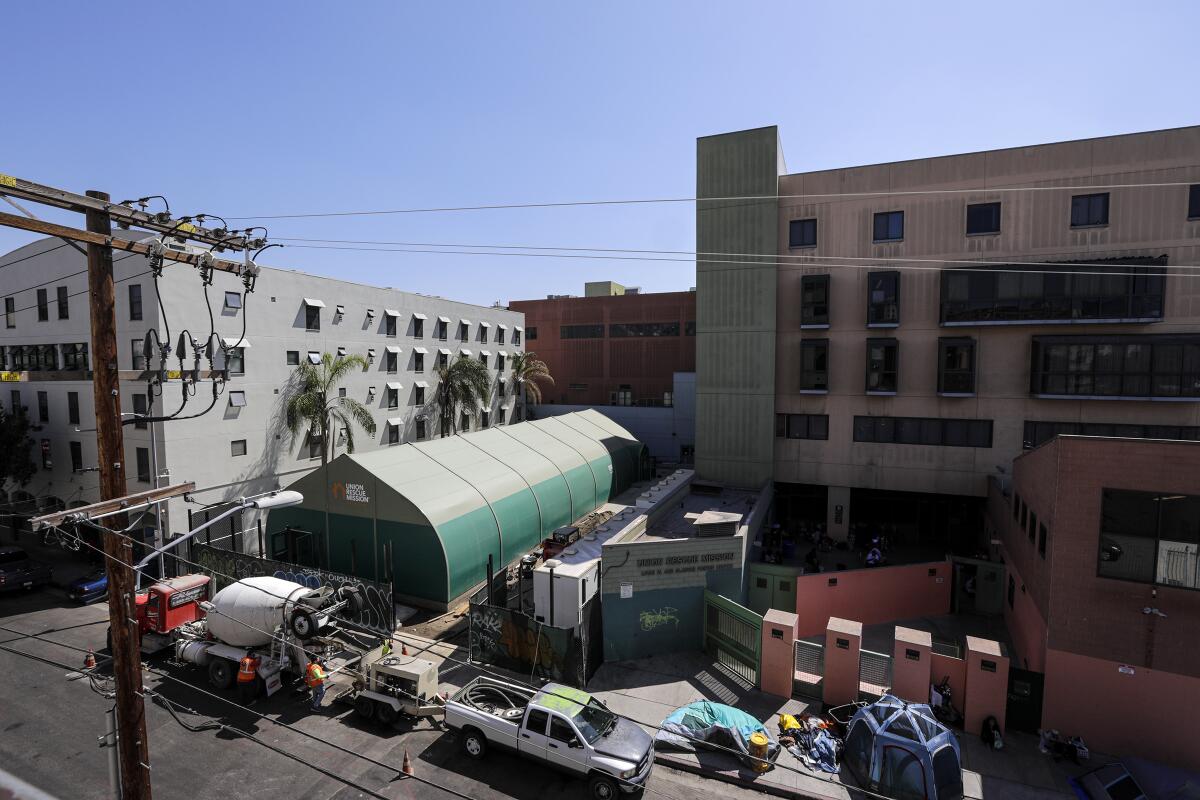
- Share via
The day after Christmas, Dr. Heidi Behforouz, medical director for L.A. County’s Housing for Health program, sent out a call of distress.
People living in skid row shelters were being diagnosed with dozens of new cases of COVID-19, and Behforouz needed a place to send them quickly to isolate.
The call went to the Rev. Andrew J. Bales, chief executive of the Union Rescue Mission, which before the pandemic had erected a large tent behind its five-story building on skid row to make room for more people without a home.
“We were able to make yet 1 more chess move against this Monster Genius Covid,” Bales said in an email to The Times. “We moved our men inside to 2nd floor and handed over keys last Sunday.”
The tent at Union Rescue Mission became an impromptu triage center as Housing for Health struggled to respond to a sudden surge in the spread of the disease through the homeless shelter system.
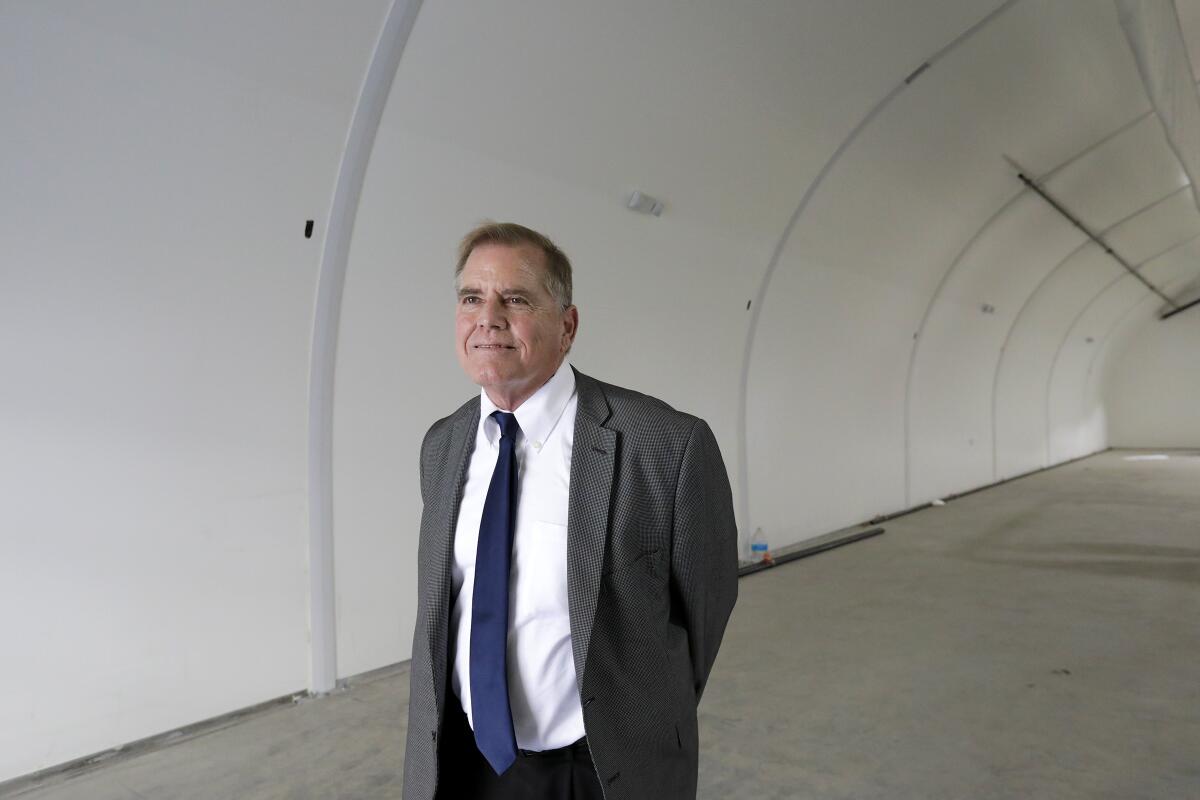
Though infections among the homeless have generally lagged slightly below the county’s per capita rate, belying early predictions of devastating outbreaks in shelters and encampments, the December surge has brought a spike in the homeless numbers as well, further straining the overstretched services system.
After averaging about 60 new cases each week through the fall, infections of homeless people doubled in the week after Thanksgiving and have since continued to climb sharply. On Tuesday, the Department of Public Health’s latest report showed 547 new cases in the previous week.
“The unexplainable protection that people who are homeless have had from COVID is disappearing,” Bales said. “All of skid row and many agencies/missions are hot spots. All are overwhelmed.”
Evangelical Christian supporters of singer Sean Feucht clashed with protesters over masks and social distancing at a skid row event.
The outbreaks have hit skid row especially hard, forcing the county to improvise.
“We saw there were a few shelters having outbreaks in skid row,” said Cheri Todoroff, director of Housing for Health. “We wanted to move very quickly.”
The Union Rescue Mission, which had worked closely with the county Department of Health Services after a COVID outbreak there in March, was ideal because of its central location.
“We could just walk the clients over, make them comfortable and do clinical assessments,” Todoroff said Thursday. “We have been using that way only since this weekend.”
Housing for Health, a Department of Health Services program that provides housing for medically vulnerable homeless people, runs the county’s coronavirus isolation and quarantine system.
To keep up with the upsurge in cases, the agency opened four new isolation/quarantine sites in December, more than doubling the available beds.
The rapid response was partly assisted by the state’s Project Homekey program through which the county has purchased 10 motels and hotels for homeless housing. Most are being used as interim housing before being converted into permanent homes. Two have been converted temporarily into medical isolation/quarantine sites.
A third site was set up in a motel that was phased out of Project Roomkey, the program to house medically vulnerable homeless people during the pandemic. A nonprofit provided the fourth site on a property it had acquired for a future project.
The sites are being staffed by several nonprofits, including PATH, Exodus, The People Concern and JWCH Institute, with clinical services shared by Holliday’s Helping Hands and the Department of Health Services.
“Staffing has been one of the biggest challenges throughout COVID, not just in Housing for Health, across homeless services sector and healthcare and hospital field,” Todoroff said.
The sites were opened quickly with just a few beds and expanded as staff came on board, she said.
“It’s been an amazing effort to stand up this kind of operation,” Todoroff said. “We haven’t done anything like this before. We have so many partners. Everybody always shows up.”
Even as it was catching up with the new beds, now numbering 820, Housing for Health has had to restrict admissions for the first time.
“Throughout summer and fall we did have beds available pretty much most days,” Todoroff said. Through that period, about two-thirds of those in isolation or quarantine were homeless. The remainder were people being discharged from hospitals and those with housing conditions that made isolation impossible.
“When the surge started in December, we had certain days when we may not be able to accept referrals,” Todoroff said.
As a result, the sites are now predominantly occupied by homeless people, she said.
The clients, who have to stay isolated for up to two weeks, are not sent back to the street. Housing for Health finds placements, generally in shelters or recuperative care centers, and transports them.
“It’s hard,” Todoroff said, adding that the entire shelter system is being hit now.
Early in the pandemic, homeless services and healthcare providers worked desperately to slow the transmission in homeless populations.
Shelters across the county removed beds to achieve the social spacing recommended by the federal Centers for Disease Control and Prevention.
After the March outbreak, the Union Rescue Mission reduced its capacity by more than half. The tent, initially for women, became what Bales called a MASH unit for men who tested positive.
“We moved all of our ladies inside to 5th floor dorms,” he said.
On the streets, city and county officials sent out more toilets and hand washing stations. Beefed-up outreach teams urged camp dwellers to isolate in their tents. L.A. city suspended cleanups at encampment that forced dwellers to leave the tents where health officials were advising them to isolate.
Housing for Health deployed 30 teams to engage homeless people. They have conducted 76,000 tests in shelters and 17,000 in encampments, Todoroff said.
By and large, the measures worked. The infection rate within the homeless population has generally tracked slightly below that of the county and never exceeded it. About 60% of the 4,059 cumulative homeless cases reported last week occurred in shelters.
Lawyers and activists for homeless people are decrying city “cleanups” near shelters
But recently, the Los Angeles City Council authorized cleanups to resume at some sites, drawing criticism from homeless activists.
“There is simply no public health justification for continuing the displacement of unhoused residents at this time,” Shayla Myers, an attorney for the Legal Aid Foundation of Los Angeles, wrote in a Dec. 21 letter to Mayor Eric Garcetti. “Doing so places unhoused residents and the community at significant, unnecessary and foreseeable risk.”
On Thursday, Bales said he was alarmed to learn that there were 90 new cases overnight, including a hot spot at a park near Union Rescue Mission.
“We aren’t winning, just barely holding our own,” Bales said. “These are the toughest times in my career, life, and in the 130-year history of Union Rescue Mission.”
More to Read
Sign up for Essential California
The most important California stories and recommendations in your inbox every morning.
You may occasionally receive promotional content from the Los Angeles Times.
